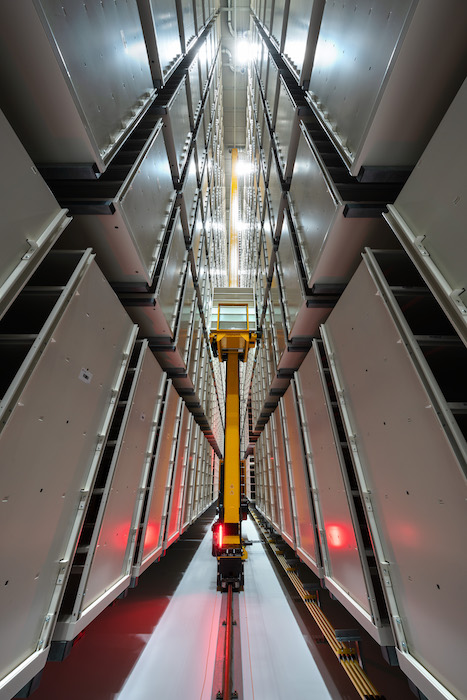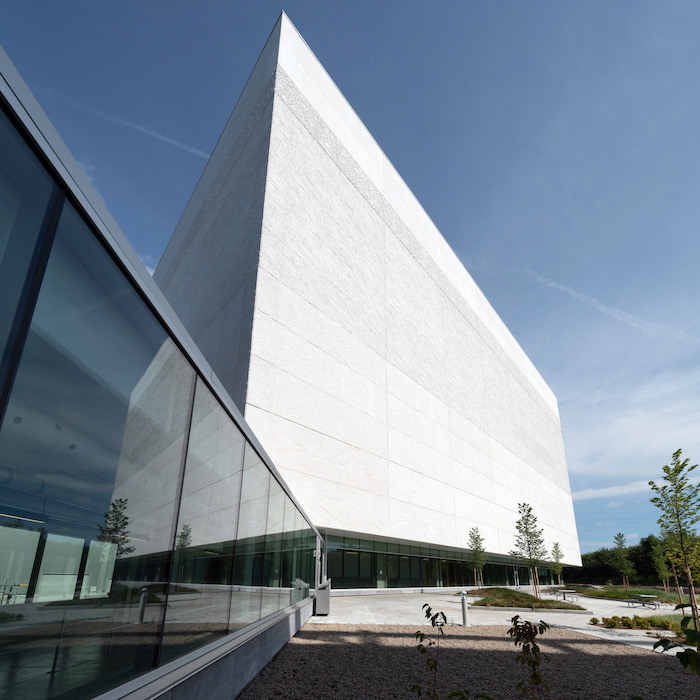
2023 #CCEAwards Showcase: LAC Preservation Storage Facility
October 23, 2023
By CCE
“A unique showcase project featuring an impressive use of automation, climate control, fire detection and water avoidance.” – Jury
Category: Buildings
Engineering A Better Canada Award and Award of Excellence Winner: Stantec
Library and Archives Canada (LAC), a federal government institution, sought a sophisticated and ecologically responsible building to increase its storage capacity in controlled ambient conditions. Stantec, as project engineer, was tasked with creating these ideal conditions to preserve Canadian heritage assets for the next 500 years, redefining archival standards. The firm also met the government’s expectations for sustainable development, with the first federal special-purpose building to meet the requirements of the Greening Government Strategy.
“This building has set a benchmark for archival preservation facilities worldwide,” says Brian Budden, president and CEO of Plenary Americas, which led the project.
Indeed, project director Nathalie Éthier says the high quality of the infrastructure is already attracting attention from around the globe, to the point where contact has been established with such countries as France, South Korea, Australia and the U.S.
An unprecedented project
The public-private partnership (P3) project dubbed ‘Gatineau 2’ involved constructing a new building, linking six controlled-environment vaults to the existing LAC preservation centre. These spaces, which can accommodate 21,328 m3 of archival documents, are operated with an automated storage and retrieval system—making it the largest automated records centre in the world.
Never before had a controlled museum environment been designed for a volume of space of such magnitude. Gatineau 2 was also the first automated records centre in North America to be designed to a net-zero carbon standard. Stantec was responsible for all of the engineering.
To optimally preserve documents and microfilms, the ambient temperature should remain between 6 and 10 C, with relative humidity of 30% to 40%. With motorized cranes producing heat and the risk of air stratification, collaboration was needed with robotics consultants, computational fluid dynamics (CFD) simulations and commissioning professionals.
Another daunting challenge involved fire protection, which had to meet the centre’s extremely high functional criteria. As the standards of the National Fire Protection Association (NFPA) do not specify requirements for 28-m high vaults, such standards had to be redefined.
Consequently, the building relies on fire detection by air aspiration, a pre-action system with a simple inter-barrier to prevent the presence of water at the level of the vaults and pipes maintained under nitrogen pressure to maintain a sterile environment.
Smart specifications
Spread across seven different offices, the project’s teams used information sharing and building information modelling (BIM) on an accelerated design schedule and with an integrated approach.
Strict temperature and humidity control had to be guaranteed without interruption to maximize the shelf life of the collection. The installation of a model in the hall of the other building allowed the operators to test new air diffusers and become familiar with their mode of operation in the vaults. The building’s normal operations would rely on electrical systems with a neutral carbon footprint; meanwhile, in the event of an outage, the generators needed to maintain the controlled environment could use renewable natural gas (RNG).

In the event of a breakdown, the robots operate in turn, to limit requests. Photo by Roy Grogan, courtesy Stantec and LAC.
Working with the robotics consultant made it possible to optimize energy recovery when braking the cranes and to program a sequential use of the robots when they are in emergency mode, halving the need for supplementary feeding.
The assembly and construction of the shelves also proved to be a major challenge. Stantec’s team worked with suppliers to define a strategy for assembling the shelving and integrating the majority of the pipes, which helped speed up construction and limit work at heights. The concerted phasing also compensated in large part for delays caused by COVID-19 during construction.
Environmental initiatives
One of the project objectives was to achieve the Canadian Green Building Council’s (CaGBC’s) Leadership in Energy and Environmental Design (LEED) v4 Silver certification. In the end, the team helped exceed the client’s expectations, achieving Gold certification, thanks in particular to the mechanical and electrical engineers’ contributions, including reduction of indoor water use, optimization of energy performance (which reduced consumption by 29.3%), improved refrigerant management and recovery of energy from the robots’ braking.
To meet CaGBC’s Zero Carbon Building (ZCB) standards, the facility’s normal operations use electricity, as well as geothermal energy for air pretreatment, while auxiliary heating systems can be supplied with RNG. And in the event of a breakdown, the robots operate in turn, to limit requests.
The chosen site is located near a wetland inhabited by Western Chorus Frogs. Stantec’s environmental engineering teams supported the project in obtaining the required permits and developing compensation measures to integrate suitable habitats.
A project for the people
While the clients are LAC and the federal government, the Canadian people are the true beneficiaries of this project, which helps preserve a collection of heritage artifacts—including 22 million books and 425,000 works of art—for the next 500 years. So, an archived piece that entered one of the vaults in 2022 will be intact in 2522!
“This new building will make it possible to keep documents safe that bear witness to our collective past,” said the federal minister of Canadian heritage, Pablo Rodriguez, at the building’s inauguration. “Today is an important step in preserving our history.”
By optimizing resources to provide high-quality and sustainable infrastructure, meeting advanced standards and achieving the lowest possible life-cycle cost, the project team has generated a return on investment (ROI) for society as a whole.
LAC Preservation Storage Facility, Gatineau, Que.
Award-winning firm (lead designer): Stantec, Longueuil, Que. (Martin Carreau, P.Eng., PMP; Bruno Lehoux, P.Eng.; Olivier Charron, P.Eng.; Jonathan Hallée, P.Eng.; Anthony Giday, P.Eng.; Alexandre Briot, P.Eng.; Patrick Brunet, P.Eng.; Julie Massicotte, Biol.; Patrick Bourgeois, P.Eng.; Aboubakeur Bensikhelifa, P.Eng.).
Owner: Library and Archives Canada (LAC).
Other key players: Plenary Properties (design-build-finance-maintain lead), PCL Construction Eastern (builder), B+H Architects, Lapalme Rheault (architecture), Footprint (sustainable design), Dematic (automated storage and retrieval system supplier), Maya HTT (computational fluid dynamics simulations), Kolostat, Britton, Viking Fire Protection.
